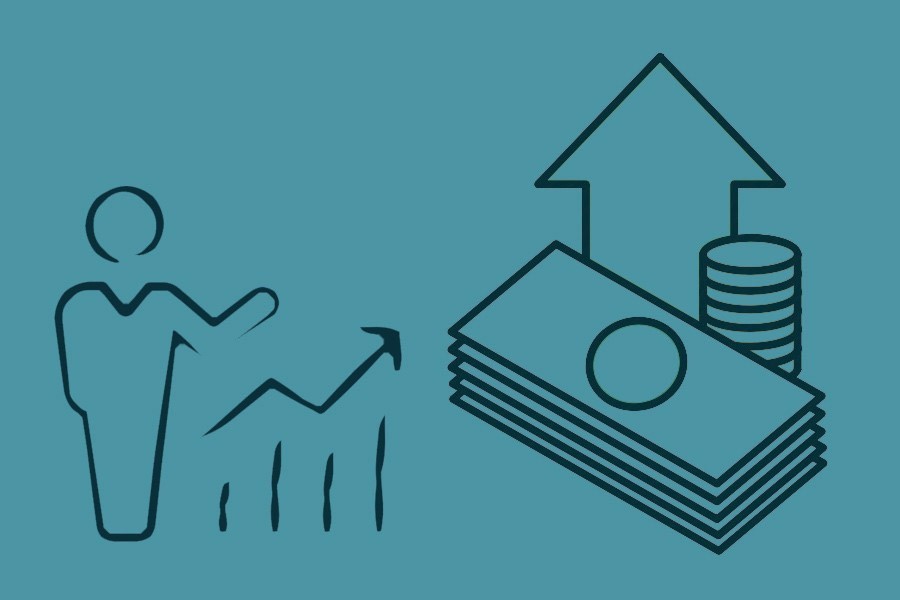Every year, per capita income has been increasing in Bangladesh thanks to the robust growth in the gross domestic product (GDP). Even during the pandemic, GDP registered modest growth which is also accompanied by the rise in per capita income. The basic macroeconomics defines GDP as the monetary value of final goods and services in a country in a given period, annually or quarterly. It considers all of the output made within the geographical territory of a country. There is also gross national product, or GNP, which considers all the output of the residents of a country excluding the foreigners' output inside the country. There is also gross national income (GNI) which is equivalent to GDP plus net factor income from abroad. Globally GDP is used as a prime benchmark of the sizes of different economies.
Per capita income of a country generally refers to GNI divided by the total population of the country. In Bangladesh, per capita income in terms of GNI is estimated at Tk 188,873 or US$ 2,227 in FY21. This is a provisional estimate in market price and is subject to revision. There is also per capita GDP which is GDP divided by the total population. In Bangladesh, per capita GDP stood at Tk 177,843 or US$2,097 in the past fiscal year.
Now, according to media reports, the per capita income of the country has crossed $2500 in the last fiscal year thanks to the revision of the national income account by rebasing GDP. The new estimate, although yet to be officially disclosed, showed that per capita income stood at $2554 in FY21, a 16 per cent rise from the previous estimate which used FY05 as the base year. The new base year is FY16.
For many, it is cheering to hear that there is a jump in per capita income, especially when it surpasses that of India. Even before updating the GDP estimate, there was a clear indication that Bangladesh is likely to outpace India in terms of per capita income. In October last year, International Monetary Fund (IMF) projected that Bangladesh's per capita GDP in dollar terms would stand at $1,888 whereas the figure for India would be $1,877. - the lowest in the last four years. In terms of per capita GNI, Bangladesh outnumbered India in FY21 when the former's per capita GNI was estimated at $2,227 against the latter's $1,947.
For a large number of Indians, it is difficult to absorb the progress of Bangladesh and some of them have started to question the rationale of comparing the two economies as the Indian economy is ten times bigger than Bangladesh. Nevertheless, some Indian analysts argued that the advancement of Bangladesh is not a fluke at all although only five years back, India's per capita GDP was around 40 per cent higher than Bangladesh's. They pointed out that during the last five years Bangladesh's per capita GDP has increased at a compound annual growth rate of 9.1 per cent against only 3.2 per cent by India during the same period. Moreover, some of them further added, nearly three decades ago, Bangladesh had a higher dollar per capita GDP for three consecutive years - 1991, 1992 and 1993. India's per capita GDP fell from $374 in 1990 to $306 in 1993, mainly due to the big devaluation of the Indian currency to fight the economic crisis, despite an increase in rupee terms. Bangladesh's per capita GDP in the meantime had remained almost static at $324 in 1990 and $322 in 1993, showed an analytical piece published in Times of India last year.
Though per capita income is an indicator of economic advancement, it depicts a partial reality and does not reflect the standard of living. It is also not possible to get any clear idea about the well-being of people across the country. Being an average figure, it systematically conceals the income disparity and real purchasing power. Assuming that the country has a population of around 170 million, the per capita income of Tk 219,644 or $2554 (exchange rate of $1=Tk 86) doesn't mean that all the people have the same level of annual income. Some other proxy indicators show that some people are enjoying $10,000 as per capita income while the amount for a large section of people is even below $1500. The widening income inequality is also reflected in different things. The regular sufferings of daily commuters who have to struggle hard to avail themselves of the poor public transports in Dhaka and other parts of the country are an example in this regard. The poor and unhealthy housings of thousands of low-income people in different slums in Dhaka are other examples.
In Bangladesh, during the Covid-19 pandemic, a large number of people have lost their sources of income and fallen below the poverty line. For many, their real income has eroded significantly due to inflation coupled with job loss or pay cuts. The plights of millions of ordinary people are visible in different sectors and reflected in some other proxy indicators.
Despite a jump in per capita income in the official statistics, these people have little to cheer for as their incomes do not provide the opportunity to spend and consume even modestly. They need to work extra hours to meet their various needs.
Thus jump in per capita income may be illusionary in many cases. It has to be matched with other indicators like income distribution, consumption patterns, smooth mobility and decent work. It also needs to tally with food and nutrition intakes as well as housing and sanitary conditions. So, a different set of indicators like the ease of living index are necessary for Bangladesh. India has already developed the index which is 'an assessment tool evaluating the quality of life and the impact of various initiatives for urban development.' Obsession with GDP growth and rising per capita income may weaken the real socio-economic advancement in the near future.


